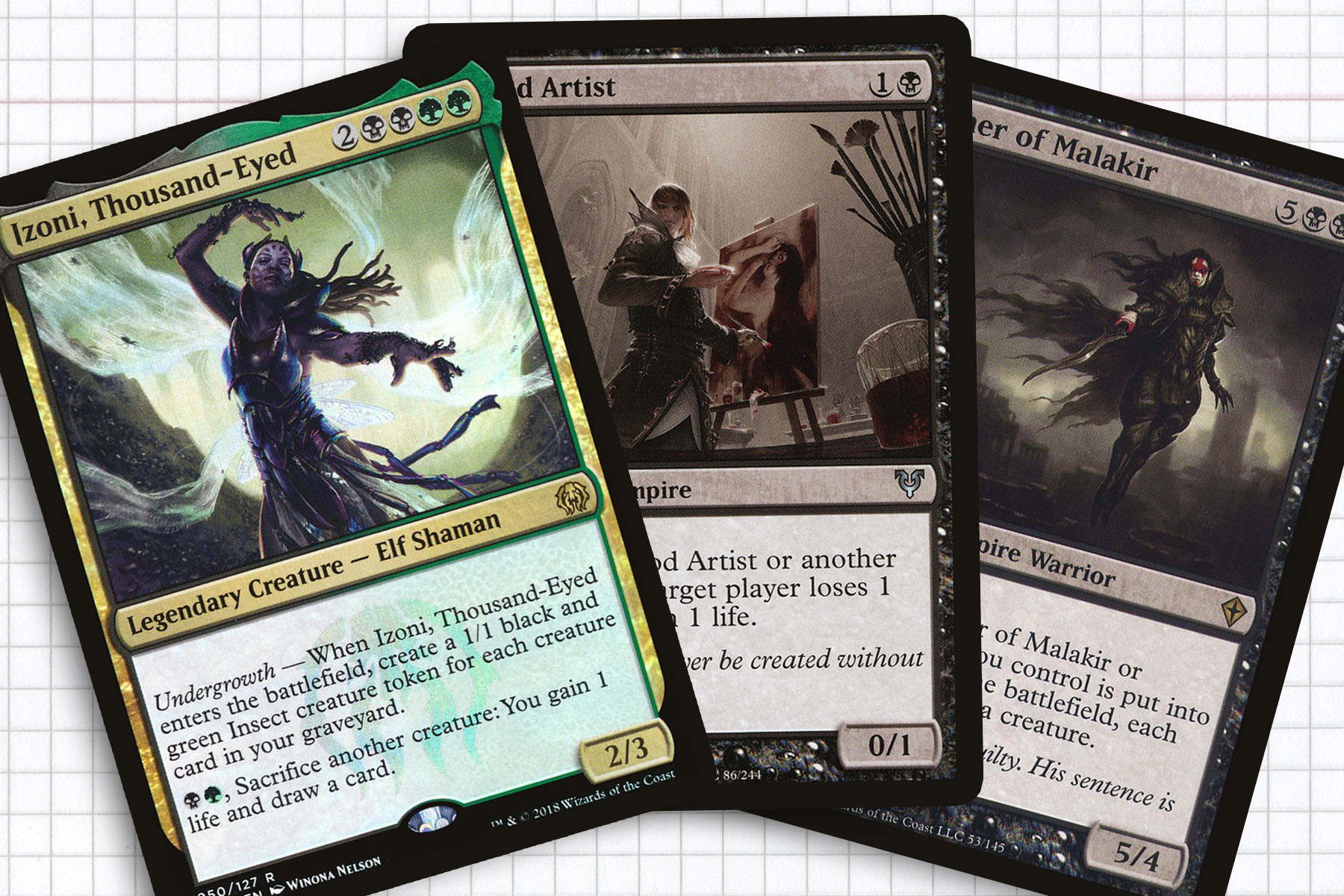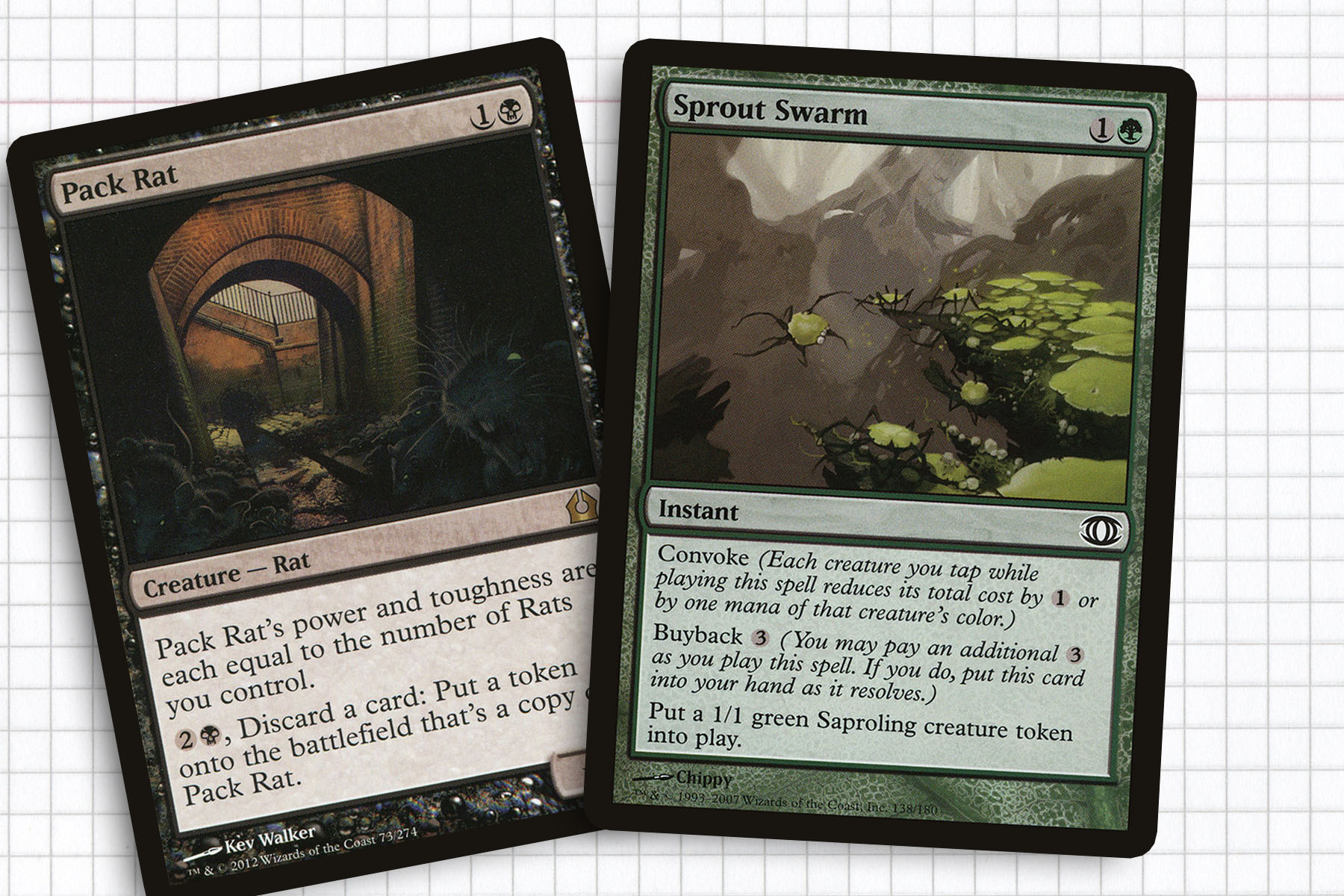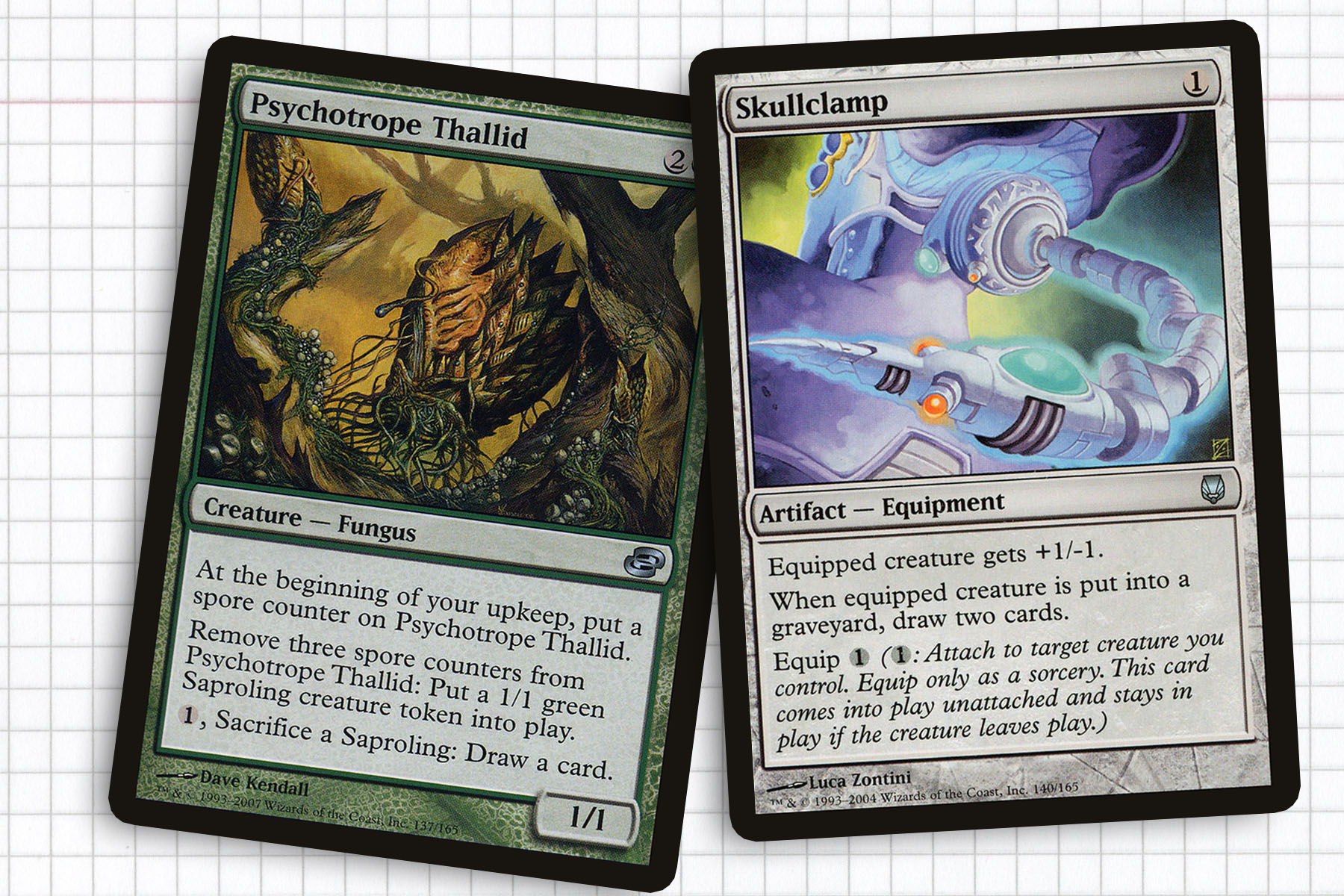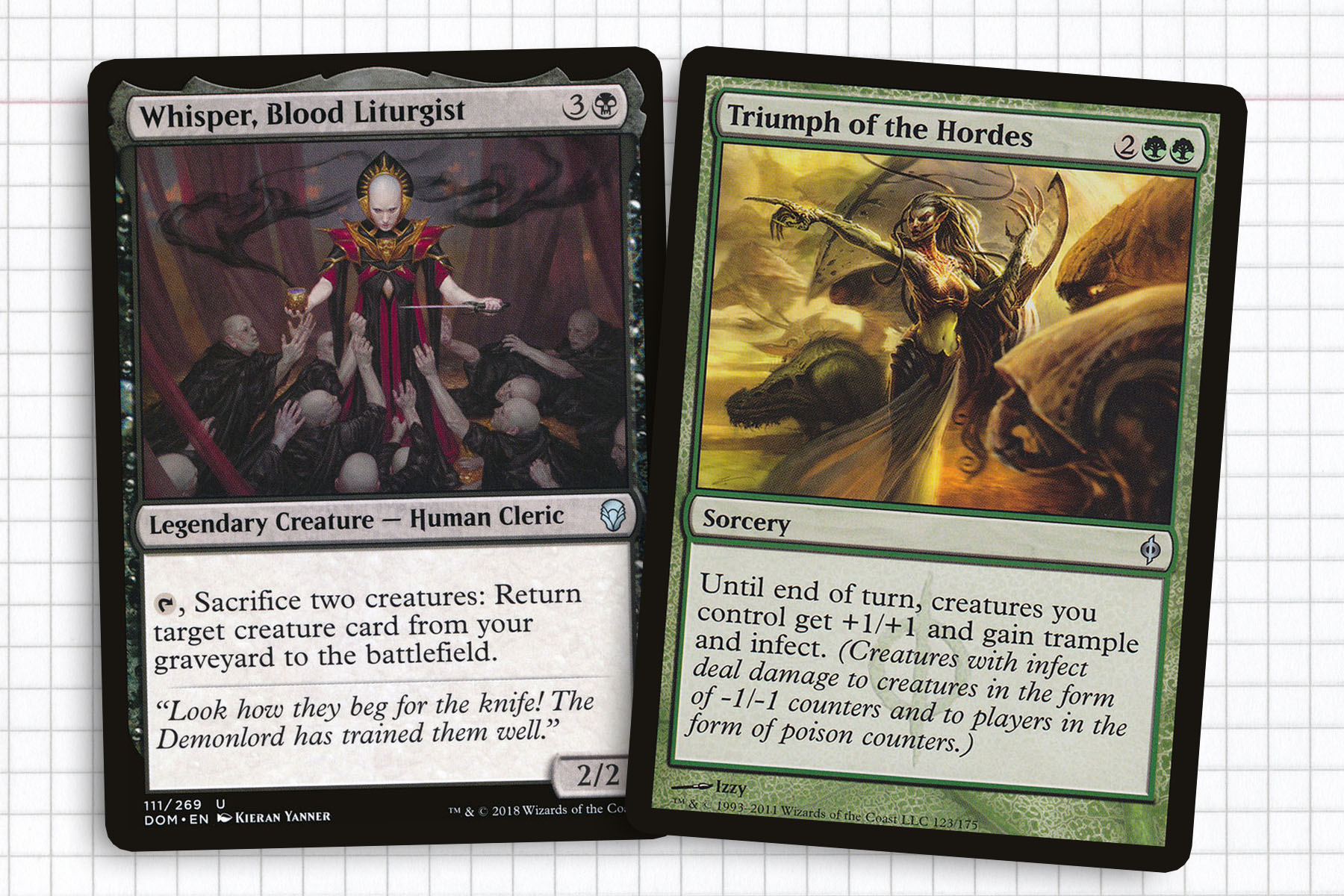Hello everybody, welcome back to the third installment of Ravnica Month, and my final article of the year. During part one I covered Niv-Mizzet, the Firemind in hopes of highlighting the deck’s straightforward game plan and potent two-card combos. And last time, I considered Teysa, Envoy of Ghosts, looking to push politics and keep player interaction at the forefront through the voting and monarch mechanics.
Today, I want to make resource management the focus as we build around Izoni, Thousand-Eyed, a role-player in a lot of decks that could just as easily lead. The motivation comes from seeing the printing of Izoni and Slimefoot, the Stowaway in the same year, as both play with similar resources and would be strong second-in-command in each other’s deck. Additionally, the forthcoming Orzhov mechanic Afterlife signals toward Standard having the broad strokes of what we’ll be looking for in this deck with cards like Tendershoot Dryad, Thrashing Brontodon, Pitiless Plunderer, and Poison-Tip Archer all representing the different archetypes we’ll be looking to emulate.

Izoni, Thousand-Eyed
Izoni exists in a set that we are still currently working through the story of, so I’m not really sure what to say about Guilds of Ravnica’s Legendary Elf Shaman. It’s possible that she will get lost in all the chaos of the meta-block, or it’s equally possible that we might see something develop with her character once the novel comes out this Spring. What I like about what this card is how it asks you to be creative with how you manage all of your in-game resources; life, hand, graveyard, and available deck. All culminating in a deck that asks you to be cognizant of how the game is progressing from start to finish.
Whereas our first trip to Ravnica took place in my teens during a time when my deeper understanding of Magic was blossoming, and our second trip took place when I thought I had a better hold on the game; at this point, our third trip is taking place at my most experienced. In that time I have gone from not understanding tempo and card advantage to feeling like I’m at the peak of my understanding of how to best manipulate these resources. This doesn’t always result in me playing optimally, because it is Commander; but I do feel that I have a better grasp on the resources of life, cards in hand, and creature tokens in ways I never did before.
Izoni is a living and breathing Spider Spawning when it comes to general choices. With this in mind, I think an Aristocrats-style deck is slumbering just below the surface with this general. The archetype looks to use armies of small creatures that carry enter the battlefield or dies triggers in combination with sacrifice outlets to churn through different forms of card advantage. While the king of this archetype is Ghave, Guru of Spores, Commander players often strive for style points and restricting color identity for the sake of flavor—especially on Ravnica—is a common way to achieve archetypical goals with signature style. We’ll be looking to make the most out of our creatures, pushing board and card advantage in our favor. This deck might require the most forward thinking of the decks I have covered during Ravnica Month: tracking the contents of our board, hand, and graveyard to achieve victory.

Sprouting Out
I think one concept of card advantage that took me the longest to understand was the value of cards that make tokens. Anytime a card can represent more than one creature on the battlefield, especially creature cards, we should be excited. I can remember my then-mentor Jesse trying to drill the philosophy into my brain as early as the printing of Selesnya Guildmage and just not getting it. This sadly continued on until the printing of Pack Rat, which might be one of the best cards for this deck. Pack Rat creates more copies of itself to use as sacrifice fodder, while getting creatures cards into our graveyard without having to go through the motions of casting them if they were dead in out hand to begin with. It’s perfect.
Since we want most creatures to die triggering our Smothering Abomination and Zulaport Cutthroat, it’s important to keep Mycoloth and any devour creature in our color identity in mind to get peak results. I also don’t want to overlook Sprout Swarm—and by extension, Second Harvest—which plays well with the strategy we’re crafting, using creature tokens for a steady stream of more creature tokens. As a green and black deck, reacquiring cards from our graveyard is a simple matter, whether through Eternal Witness or Rise of the Dark Realms. So once we’ve gotten a strong Undergrowth effect from summoning Moodmark Painter, Lotleth Giant, or our general, we can always turn our trash back into treasure.

Finding a Dead Body
So we have a use for creatures in the graveyard and we’ve already gone over ways to get a healthy supply of creatures, but how are we going to ensure that the creatures we have will eventually die? This is a pretty easy problem to solve as long as we keep enough sacrifice outlets in our deck. The most popular options are Ashnod’s Altar and Skullclamp, but really any sacrifice outlet is going to be helpful such as Carrion Feeder, Psychotrope Thallid, or Nantuko Husk. The most important feature of these cards is efficiency: we want to be able to sacrifice creatures through the use of minimal to no amount of mana to allow us to continue to play the game while pushing our agenda.
Another excellent route is to simply have the sacrifice outlet stapled to a creature like Thrashing Brontodon mentioned earlier. Caustic Caterpillar, Yavimaya Elder, and Shambling Shell all come to mind as creatures that get themselves into the graveyard at little to no cost and do something in passing or from the graveyard. The point being, we should not at all be afraid of losing our creatures, as the act of them dying is only progressing our game.

A Desired Game State
So what does the game look like when we’re winning? Because of the archetype we’ve chosen to play, we want our creatures to be going in and out of play on our side of the battlefield as often as possible—gaining mana, life, and card advantage through either our general or any of the sacrifice outlets I’ve previously laid out. This could include the use of Jarad, Golgari Lich Lord or Sadistic Hypnotist to start stripping our opponents of the resource of life and card advantage respectively. Then we can recur creatures like Acidic Slime with Sheoldred, Whispering One or Whisper, Blood Liturgist, slowly denying opponents the resources we haven’t already messed with.
Because of our color identity, we can gain card advantage in more unlikely ways by making metaphorical “deals with the devil” through Necropotence, Recycle, and Null Profusion. And ultimately our vast creature army can win through cards like Overrun, Triumph of the Horde, and Craterhoof Behemoth. A game with Izoni at the help is likely to be an awkward arms race from the perspective of anyone other than us, because the true appeal and staying power of this deck is adaptability. No longer are we making simple choices on rails or leaving the direction of our game plan up to our opponents. If we play economically and smart, our creatures should never be destroyed or exiled profitably by our opponents. Through our general, any creature that is threatened by a spell or blocker should simply net us life and card draw.
When Izoni, Thousand-Eyed was previewed, I saw a lot of promise in it as a possible general but honestly didn’t know what to do with it. The answer came when I abandoned my preconceived notions about card advantage and started to look at what the deck was asking me to do to achieve its version of fun gameplay. It’s not always in the forefront of my mind to look at resources like creatures or life points as bargaining chips—trying to track a hand, battlefield and graveyard can be taxing—but sometimes that challenge can be a great change of pace.
Like I said at the top, this is my last article for the year, unless something really really inspiring comes about. So as we push on 2019, I would like to thank all my readers that have stuck with me over the last year and all the people that I’ve grabbed the attention of at the same time. Hopefully 2019 will bring with it even more inspired articles and hopefully better and better writing each and every week. I wish safe travels to everyone over the holidays. See you next year.
Ryan Sainio is a Graphic Designer who writes about EDH, the EDH community, and streams on Twitch in his down time. He has been playing Magic: The Gathering since 7th Edition in 2002 and values flavorful and fun gameplay over competitively optimized decks. Join him for a stream at twitch.tv/hipstersainio on Tuesday nights.

